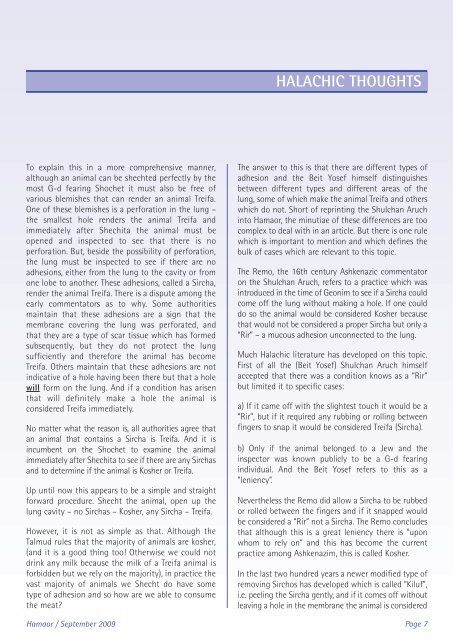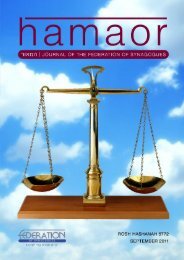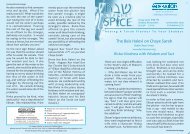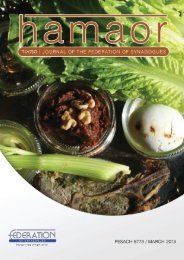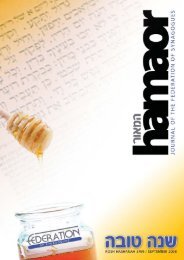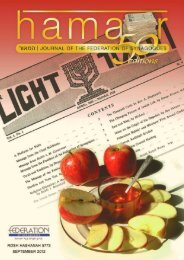20903 Hamoar cover - Federation Of Synagogues
20903 Hamoar cover - Federation Of Synagogues
20903 Hamoar cover - Federation Of Synagogues
You also want an ePaper? Increase the reach of your titles
YUMPU automatically turns print PDFs into web optimized ePapers that Google loves.
HALACHIC THOUGHTS<br />
To explain this in a more comprehensive manner,<br />
although an animal can be shechted perfectly by the<br />
most G-d fearing Shochet it must also be free of<br />
various blemishes that can render an animal Treifa.<br />
One of these blemishes is a perforation in the lung –<br />
the smallest hole renders the animal Treifa and<br />
immediately after Shechita the animal must be<br />
opened and inspected to see that there is no<br />
perforation. But, beside the possibility of perforation,<br />
the lung must be inspected to see if there are no<br />
adhesions, either from the lung to the cavity or from<br />
one lobe to another. These adhesions, called a Sircha,<br />
render the animal Treifa. There is a dispute among the<br />
early commentators as to why. Some authorities<br />
maintain that these adhesions are a sign that the<br />
membrane <strong>cover</strong>ing the lung was perforated, and<br />
that they are a type of scar tissue which has formed<br />
subsequently, but they do not protect the lung<br />
sufficiently and therefore the animal has become<br />
Treifa. Others maintain that these adhesions are not<br />
indicative of a hole having been there but that a hole<br />
will form on the lung. And if a condition has arisen<br />
that will definitely make a hole the animal is<br />
considered Treifa immediately.<br />
No matter what the reason is, all authorities agree that<br />
an animal that contains a Sircha is Treifa. And it is<br />
incumbent on the Shochet to examine the animal<br />
immediately after Shechita to see if there are any Sirchas<br />
and to determine if the animal is Kosher or Treifa.<br />
Up until now this appears to be a simple and straight<br />
forward procedure. Shecht the animal, open up the<br />
lung cavity – no Sirchas – Kosher, any Sircha – Treifa.<br />
However, it is not as simple as that. Although the<br />
Talmud rules that the majority of animals are kosher,<br />
(and it is a good thing too! Otherwise we could not<br />
drink any milk because the milk of a Treifa animal is<br />
forbidden but we rely on the majority), in practice the<br />
vast majority of animals we Shecht do have some<br />
type of adhesion and so how are we able to consume<br />
the meat?<br />
Hamaor / September 2009<br />
The answer to this is that there are different types of<br />
adhesion and the Beit Yosef himself distinguishes<br />
between different types and different areas of the<br />
lung, some of which make the animal Treifa and others<br />
which do not. Short of reprinting the Shulchan Aruch<br />
into Hamaor, the minutiae of these differences are too<br />
complex to deal with in an article. But there is one rule<br />
which is important to mention and which defines the<br />
bulk of cases which are relevant to this topic.<br />
The Remo, the 16th century Ashkenazic commentator<br />
on the Shulchan Aruch, refers to a practice which was<br />
introduced in the time of Geonim to see if a Sircha could<br />
come off the lung without making a hole. If one could<br />
do so the animal would be considered Kosher because<br />
that would not be considered a proper Sircha but only a<br />
“Rir” – a mucous adhesion unconnected to the lung.<br />
Much Halachic literature has developed on this topic.<br />
First of all the (Beit Yosef) Shulchan Aruch himself<br />
accepted that there was a condition knows as a “Rir”<br />
but limited it to specific cases:<br />
a) If it came off with the slightest touch it would be a<br />
“Rir”, but if it required any rubbing or rolling between<br />
fingers to snap it would be considered Treifa (Sircha).<br />
b) Only if the animal belonged to a Jew and the<br />
inspector was known publicly to be a G-d fearing<br />
individual. And the Beit Yosef refers to this as a<br />
“leniency”.<br />
Nevertheless the Remo did allow a Sircha to be rubbed<br />
or rolled between the fingers and if it snapped would<br />
be considered a “Rir” not a Sircha. The Remo concludes<br />
that although this is a great leniency there is “upon<br />
whom to rely on” and this has become the current<br />
practice among Ashkenazim, this is called Kosher.<br />
In the last two hundred years a newer modified type of<br />
removing Sirchos has developed which is called “Kiluf”,<br />
i.e. peeling the Sircha gently, and if it comes off without<br />
leaving a hole in the membrane the animal is considered<br />
Page 7


